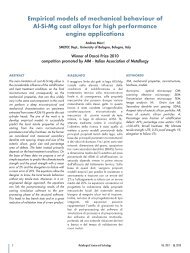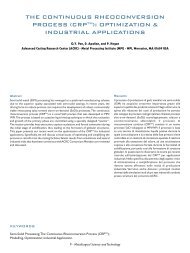PDF, about 5Mb - Teksid Aluminum
PDF, about 5Mb - Teksid Aluminum
PDF, about 5Mb - Teksid Aluminum
You also want an ePaper? Increase the reach of your titles
YUMPU automatically turns print PDFs into web optimized ePapers that Google loves.
A) B)<br />
Fig. 8: Fracture surface of cracks propagated at 130°C in specimen with CL orientation of 2014-A (a) and 2618 (b) forgings.<br />
4. DISCUSSION<br />
In the examined forgings crack propagated in a<br />
ductile manner, in some cases by an intergranular<br />
ductile mode, linking the early fractured coarse<br />
intermetallic particles, located at inter or<br />
intragranular position in the different materials<br />
investigated.<br />
Following the approach proposed by Hahn and<br />
Rosenfield [2] for aluminium alloys, it can be stated<br />
that crack propagates when the size of extensive<br />
plastic strain formed ahead of the crack tip<br />
corresponds to the average coarse interparticle<br />
distance (δ) Further, according to these authors,<br />
K and d are correlated as follows:<br />
δ =(0.5K 2 )/(E•YS) (5)<br />
In the case of 2618 forging the δ values estimated<br />
using room temperature tensile and toughness<br />
properties were 11 and 15 µm for specimen<br />
orientations CL and CR, respectively, comparable<br />
to the average interparticle size between the<br />
intragranular particles (mainly FeNiAl 9 particles)<br />
in longitudinal and radial direction, respectively. The<br />
preferred particle orientation and their tendency<br />
to align axially in the forging regions where<br />
specimens were sampled corresponds to a greater<br />
CONCLUSIONS<br />
The toughness properties in opening mode I of<br />
forgings made of AA2014 and AA2618 aluminium<br />
alloys with different microstrctural conditions were<br />
presented.<br />
Fracture toughness ranged between 19 and 26<br />
MPam 0.5 , depending on the material and specimen<br />
direction. Fracture toughness was in general lower<br />
interparticle distance in the crack propagation direction of CR specimens.<br />
As previously presented, in the specimens obtained from forgings made of<br />
AA2014 alloy the crack proceeds in a ductile manner but along an<br />
intergranular path, intercepting the oriented coarse aligned intermetallic<br />
particles axially. The values of δ computed from equation 5 for these two<br />
forgings are 6.7 and 9 µm for CL and CR specimen of 2014-A forging,<br />
respectively. In the case of the last forging (2014-B), δ equals 12 µm for<br />
both CL and CR directions. Thus, also in the case of AA2014 alloy, d is<br />
comparable to the interparticle distance along the crack path. It can be<br />
thus stated that fracture toughness is correlated to the mean interparticle<br />
distance along the crack path.<br />
The above observations well agree with the simple correlation proposed<br />
by Hahn and Rosenfield [2] for the case of forged Al-alloy parts (where<br />
fracture is initiated by cracking of large intermetallic particles once reached<br />
critical stress/strain levels in the region of extensive deformation at the<br />
crack tip [3]) and fracture toughness is correlated to the mean interparticle<br />
distance along the crack path.<br />
Thus, forgings of the same heat treatable alloy, even in the same heat<br />
treatment condition and with comparable hardness and tensile properties<br />
can show significantly different fracture behaviour, depending on intermetallic<br />
particle population. Especially, as the mean interparticle distance along the<br />
crack path between the coarser intermetallic particles increases, the<br />
nucleation of voids at these particles is shifted at higher applied loads and<br />
toughness is improved.<br />
The role of coarse intermetallic particles and the need to reduce their<br />
amount, to optimize their size and distribution in forgings (taking into account<br />
the most critical crack propagation directions in the components) in order<br />
to increase material toughness is therefore highlighted.<br />
for specimen sampled in CL direction. In the examined forgings crack<br />
propagated in ductile manner, in some cases by an intergranular ductile<br />
mode, linking in any case the voids formed at the early fractured inter- or<br />
intragranular coarse intermetallic particles. No significant difference in<br />
toughness nor in the fracture mode was observed when tests were<br />
performed at room temperature or at 130°C.<br />
Fracture toughness properties were related to the presence and distribution<br />
of the coarse intermetallic phases within grains or at their boundaries in<br />
the different investigated alloys.<br />
10 - Metallurgical Science and Technology







